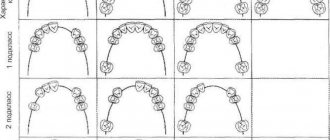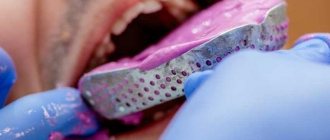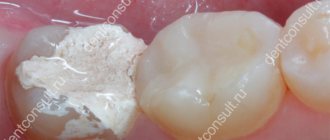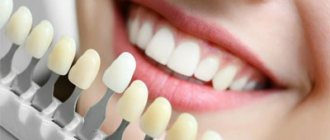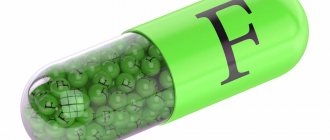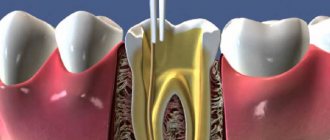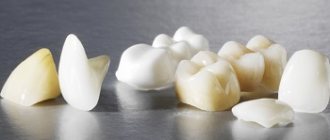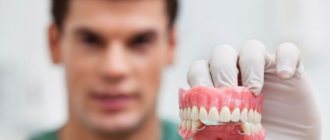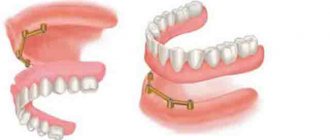Lavask wax is widely used in dentistry; it is used to create future crowns and bridge structures. Modeling wax Lavask has received well-deserved recognition among dentists; it is rightfully considered one of the best materials. Lavasc wax is used to create metal and non-metal prototypes of a future tooth. Today we will talk about Lavask modeling wax. Read the next article on the pages of the magazine, which will talk about the features of using Lavax wax.
Modeling wax Lavax
“Lavax” is a composition consisting of paraffin, natural and synthetic wax mass.
“Lavax” is a composition consisting of paraffin, natural and synthetic wax mass. Used to create prototypes of fixed prostheses: plastic crowns, half-crowns, inlays, facets, direct bridges. Available in the form of unpainted and painted sticks. The painted mass is used to model metal elements, and the unpainted mass is used to form prototypes of plastic parts of the prosthesis. Completely softens at a temperature of 55 – 60 °C. “Lavax” is moderately plastic, forms well, and does not create “delays” when removing the finished prototype from the oral cavity. When processing the surface, dry, non-viscous, light chips are formed.
LAVAX modeling wax is a paraffin-ceresin composition with special additives. LAVAX wax softens easily without delamination, and with light scraping it produces dry, non-viscous shavings. In the temperature range 43 - 48°C, the wax is plastic and easily shaped. The ash content of the wax does not exceed 0.1%.
Lavask wax is used for:
- production of plastic crowns;
- production of combined crowns;
- production of metal-plastic facets;
- production of pin teeth;
- production of half-crowns;
- production of three-quarter crowns;
- production of inlays using the indirect method.
Advantages:
- softens easily without delamination;
- produces dry, non-viscous chips;
- wax is plastic and easy to mold;
- The ash content of the wax does not exceed 0.1%.
Instructions for use:
- the wax stick is softened over the flame of the burner, preventing it from spreading;
- The softened wax is pressed with your fingers and modeling begins;
- The wax is modeled with any dental instruments.
Equipment:
- wax sticks 10 pcs. (20 g).
C tomatological wax modeling materials and their chemical composition. Classification.
Waxes are various organic substances that have physical properties similar to beeswax. Waxes are fat-like amorphous substances with a melting point of 40–90 °C. In terms of chemical composition, these are higher saturated fatty hydrocarbons, their monohydric alcohols and esters of higher essential acids. Waxes can contain all of these substances in a free state, but more often in the form of compounds called esters. Esters are formed as a result of the interaction of alcohols with acids. Waxes dissolve well in gasoline, chloroform, benzene and essential oils. Their relative density is less than 1, i.e. they are lighter than water. When heated slightly, they soften well, acquiring a high degree of plasticity. With a further increase in temperature, they easily transform into a liquid state, and then burn without residue with minimal ash content, which is important for casting processes.
The most common classification of waxes is based on their origin. Waxes are divided into the following groups:
- vegetable, these include palm or carnauba wax, herbal - candelilla wax and Japanese fruit wax;
- mineral (brown coal and peat, distillation paraffin) and fossil waxes, representatives of which are ozokerite, ceresin, and montane wax;
- synthetic waxes are divided into ethylene and polyisobutylene resins;
- animal waxes are divided into beeswax or Chinese, stearin, lanolin, spermaceti.
Beeswax is the most common substance included in the group of modeling materials. Wax is produced by the wax glands of bees during honey production.
Properties of beeswax. At room temperature, the wax is a yellowish solid with a pleasant honey smell. At the fracture, the wax has a granular structure. Purified wax has a density of 0.95–0.97 g/cm3, a softening point of 37–38 °C, and a melting point of 62–64 °C. The large temperature range from the beginning of softening to melting is the positive property that made it possible to use wax to create plastic modeling compositions. When cooled, the hardness of the wax increases, and at low temperatures it becomes brittle. Wax boils at a temperature of 236°C. At different temperatures, the coefficient of linear expansion of wax is different, which affects the manufacture of parts that require great precision. This is one of the negative properties of waxes. Thus, the coefficient of linear expansion when heated from 6 to 30°C is 0.0003.
Beeswax dissolves well in fat solvents: gasoline, ether, chloroform, essential oils, carbon disulfide. Chemically, wax is inert. Beeswax in its pure form is not used in dental practice. In orthopedic dentistry, wax is used in the form of wax mixtures—compositions. Modeling materials containing beeswax are characterized by increased plasticity. By changing the percentage of wax in the mixture, the temperature of its softening and melting is adjusted.
Another representative of animal waxes is stearin, a product of the hydrolysis of animal fat. It is a waxy material that is obtained from beef or lamb lard by breaking it down into its constituent elements: glycerin and fatty acids. The breakdown of fats into their constituent elements is carried out by hydrolysis. Hydrolysis of fats is carried out with water vapor at a pressure of 10–12 atm. or chemically under the action of a catalyst—sulfuric acid. The resulting mixture, consisting of fatty acids (stearic, palmitic, oleic), is distilled under reduced pressure. During distillation, the more volatile oleic acid is separated, then by refining with a solution of sulfuric acid, palmitic acid is partially separated, leaving stearin. It contains stearic, palmitic and a number of other fatty acids. Pure stearin is a solid substance, greasy to the touch, and has a fine-grained structure when broken. Its density is 0.93–0.94 g/cm3. Stearin softens at 50–55°C, it melts at a temperature of about 70°C, and boils at 350°C. Stearin dissolves in gasoline and chloroform, has slight plasticity (less than beeswax), and crumbles easily. When stearin is boiled with alkali, soap is formed. Stearin, tinted with dyes, can be used for modeling on plaster models, making anatomical models, and modeling prosthetic parts. More often, stearin is used as part of wax mixtures. It is introduced into the latter to reduce their plasticity, viscosity and improve the processing of wax samples with a cutting tool, as well as to increase the melting point, which is necessary in the process of modeling small parts of dentures. [U33] Corrected
Rice. 6.1. Classification [A34] of modern modeling wax materials (Prof. Kalivradzhiyan E.S., Arutyunov S.D.) No, it refers to page 141
Stearin is a component of artificial thermoplastic impression compounds. Stearin is part of the fatty base of polishing pastes. It weakens the effect of abrasive grains because it has an enveloping ability. At the same time, polishing is more gentle, and the paste remains on the polished surface longer.
Synthetic waxes include ethylene high polymers, products of paraffin hydrogenation with carbon monoxide and polyisobutylene resins. These wax compositions belong to the group of polymeric materials with stable physical and mechanical properties - melting and softening points. Synthetic waxes are included in complex wax compositions used to model parts produced by precision casting, to create clasp dentures, because tend to burn without leaving a residue in the mold.
Another component of modeling wax - rosin - is a transparent glassy brittle mass, which is mainly a mixture of resin acids. Rosin is obtained after steam distillation of volatile natural resin extracted from pine trees, or by extraction from its roots with gasoline. According to the method of production, two types of rosin are distinguished: rosin (obtained from resin) and extraction (obtained from osmol). The softening temperature, depending on the variety, is 52–68°C. In addition to rosin, its esters are used - glycerin and pentaerythritol.
Pentaerythritol ether is a hard, brittle resin with a melting point of 112–115 °C. To increase the softening temperature and lower the acid number, rosin is converted into salts - rosin resinates, treating it with metal oxides or hydroxides. In the manufacture of denture waxes, calcium and zinc resinate are used. Calcium resinates of rosin have a melting point of 135–140 °C. In denture practice, rosin and its esters are used as components of impression compounds and modeling waxes. Rosin increases the hardness of the mass and gives it stickiness. In impression compounds, rosin is replaced with ethers, which increase the softening temperature, reduce plasticity and promote the disappearance of stickiness, which is caused by the presence of rosin. Rosin is included in some polishing pastes. A number of substances are modifiers of various natures. [U35] Remove
Mineral waxes. These include lignite and peat (montanium); petroleum distillation (paraffin); fossils (ozokerite and ceresin) waxes.
Petroleum distillation plants. Paraffin. It is obtained from oil distillation, as well as from shale and coal. Paraffin oil contains from 4 to 6%. Chemically, paraffin is a mixture of solid saturated hydrocarbons. Paraffin is obtained from petroleum through the distillation process. After separating gasoline, kerosene and light lubricating oils, fuel oil remains, which contains a large amount of paraffin. The separation of pure paraffin from fuel oil is carried out by settling in a heated state at the melting temperature of paraffin. After settling, the mixture is cooled and the paraffin crystallizes. Solid paraffin, which still contains a significant amount of oils, is selected from settling tanks and squeezed out on special filter presses under a pressure of 40–50 atm. Oils and kerosene “sweat” when squeezed. The remaining paraffin is subjected to refining. Paraffin heated to a temperature of 75 ° C is mixed with concentrated sulfuric acid, then treated with alkali and bleached with clay. The result is a colorless, odorless, tasteless solid mass, very similar in properties to wax.
Pure paraffin is colorless, transparent, shiny, tasteless and odorless, has a fine-grained structure when broken, and is slightly greasy to the touch. Unlike wax, paraffin is less viscous and less flexible. When used as a modeling material, it is easily scraped off with a modeling tool. Paraffin density is 0.907–0.915 g/cm3, melting point is 42–56 °C. Paraffin dissolves in ether, gasoline, and partially in alcohol; it has a pronounced crystalline structure. Its physical properties depend on the structure of the crystals. When n-paraffins crystallize from a melt, they form a hexagonal structure. As it cools, recrystallization can occur and an orthorhombic structure is formed. During cooling of paraffin, crystals can separate from each other, and voids are formed in the paraffin mass. This phenomenon leads to complications in the production of dental wax. Hard paraffins have rhombic crystals, while soft paraffins have hexagonal crystals. The bulk of the components (hydrocarbons) of paraffin at the temperature of its use are in a solid state (orthorhombic structure). However, there is always some liquid phase in it. Liquid hydrocarbons (iso-paraffins) can be removed by homogenizing the paraffin under vacuum. For the production of dental waxes, the most suitable material is paraffin, which contains a minimum amount of various hydrocarbons and has a melting point of 54–58 °C, i.e. hard paraffin. Paraffin has a slight plasticity, brittleness, and can be easily scraped with a sharp tool. It is the main component of wax mixtures for the manufacture of denture bases at the modeling stage.
Fossil waxes
.
Ozokerite and ceresin. Ozokerite is a mineral wax that occurs in nature in the form of deposits in its pure form or, more often, impregnates sandstones and limestones.
It consists of a mixture of high molecular weight saturated hydrocarbons. Contains 85.7% carbon and 14.3% hydrogen. Ozokerite, having a low melting point, melts under boiling and floats to the surface of the water, then it is removed, cooled and boiled again for additional cleaning. In recent years, ozokerite has been obtained by extraction with gasoline. Ozokerite is a hard, resinous, sticky substance with the smell of kerosene. Ozokerite can be light green, dark green, sometimes brown—the color depends on the resinous impurities. The density of ozokerite is from 0.85 to 0.93 g/cm3, the melting point is 50–90 °C. When heated, it becomes rubbery. Due to this property, it is used as an integral part of impression materials.
Ceresin differs from ozokerite in its light color (white or yellow), greater hardness, and less stickiness. Its density is 0.91–0.94 g/cm3, melting point is 60–85 °C, and when heated it becomes viscous and viscous. Significant fluctuations in the melting point are explained by the heterogeneity of the composition. Some varieties of ozokerite contain asphalt and sulfur.
Ceresin is a product of deresined, purified (refined) ozokerite. Removal of ozokerite is carried out by treatment with concentrated sulfuric acid when heated to a temperature of 170–180 °C. The asphalts contained in the resin are destroyed by sulfuric acid, and their decomposition products are separated with bleaching clays or sawdust. Ceresin is a mixture of solid hydrocarbons of the methane series. The produced ceresin is characterized by grades 57, 67, 75, 80, 95. These numbers correspond to the minimum dropping temperatures. The color depends on the degree of purification and varies from yellow to white. Pure ceresin, unlike ozokerite, is white or yellow in color, does not have the same stickiness as ozokerite, is more fragile, can be easily cut with a knife, does not stick to the teeth, does not crumble when kneaded in the hands, and is more resistant to oxidation than paraffin. Specific gravity 0.91–0.94, melting point 60–85 °C.
Ozokerite and ceresin dissolve in gasoline, acetone, chloroform, and carbon disulfide. The industry produces a ceresin composition, which is a mixture of 40% ceresin, and the rest is paraffin. The drop point of the composition is not lower than 56 °C. In orthopedic dentistry, ozokerite and ceresin are used as components of thermoplastic masses and wax mixtures. They are introduced to increase the melting point, viscosity and hardness of mixtures. Both substances are included in thermoplastic impression compounds.
Lignite and peat waxes. Montan (or montan) wax belongs to the group of fossils. Its composition is close to ceresin, it consists of a mixture of saturated hydrocarbons, esters of higher fatty acids and alcohols, its melting point is 73–80 °C. Montan wax is found in brown coal deposits, from where it is extracted with solvents. It is not used in its pure form. Added to wax modeling mixtures to increase melting point and increase hardness
Vegetable waxes. Carnauba and Japanese waxes are most widely used in orthopedic dentistry. Carnauba wax is extracted from the leaves of a special type of palm tree growing in Brazil. Carnauba wax has a grayish-green or yellowish-green color, a resinous odor, a scaly structure, is hard when broken, brittle at room temperature, cannot be cut with a knife—it crumbles. Its density is 0.999 g/cm3. Wax softening occurs at a temperature of 40–45 °C, melting point 83–90 °C. Wax dissolves well in boiling alcohol and ether; when heated in gasoline or turpentine, it forms an ointment-like mass.
The chemical composition includes palmitic, cerotic, butyric acid and alcohols. In its composition it is close to beeswax. In orthopedic dentistry, carnauba wax is rarely used in its pure form. This largely depends on its high cost. In its pure form, wax is used to restore plaster models in case of violations of the anatomical shape of the teeth. Carnauba wax is added to wax compositions to impart greater hardness, reduce ductility, increase the melting point, and better workability. The latter quality is associated with the ability of wax to scrape off well and separate in the form of shavings, which is important for some modeling work that requires great precision. This wax mixture is used for modeling clasp dentures, clasps before casting, as well as for modeling inlays and half-crowns.
Japanese wax
-
a product of certain species of trees growing in subtropical climates.
It was first extracted from the fruits of trees growing in Japan. Japanese wax is a solid substance, its density is 0.999 g/cm3. The softening point is in the range of 34–36°C, the melting point is 52–53°C. Heated Japanese wax has increased plasticity and adhesiveness. Its composition includes fatty acids: palmitic, stearic, butyric and glycerin. It dissolves well in gasoline, chloroform, carbon disulfide, and benzene. Japanese wax is added to wax modeling mixtures in order to increase viscosity and strength, and give the mixture a green color. Wax mixtures with it have good adhesive ability. In dental practice, waxes are often used in compositions that contain various components. These mixtures are characterized by the content of natural synthetic waxes, resins, fats and fatty acids, oils, pigments and dyes. All these components, correlated with each other in a certain proportion, make it possible to obtain wax with a set of dominant properties, which predetermine their use. Depending on the purpose, wax mixtures (compositions) come in the following varieties: - base, clasp, modeling for fixed dentures, including submersible [U36] and mixtures for inlays, profile, sticky, etc.
Properties of wax compositions
In dental materials science, a variety of research and testing methods are used to obtain fairly complete and reliable information about the properties of materials and their changes depending on the chemical composition, structure and application technologies. Properties of materials include physical, mechanical, chemical, technological and biological indicators
The study of these data is of great practical importance related to the quality of manufacturing of dentures, medical devices, etc. The success of orthopedic treatment largely depends on the properties of both structural - basic and auxiliary materials
Waxes and wax compositions have a number of properties that are variable. These properties include melting and softening points, hardness, elasticity, plasticity, viscosity, and fluidity. This largely depends on the composition of the raw materials from which the waxy substance is obtained, as well as on the technology for its production.
It should be borne in mind that waxes are amorphous substances, the melting of which when heated does not occur immediately, but for some time over a temperature range of several degrees. When heated, these substances first soften, and with a further increase in temperature they lose their viscosity and become liquid. The vast majority of solids that have the ability to melt expand when melting and contract when solidifying. A feature of waxes and wax compositions is a high coefficient of thermal expansion or contraction, which is a negative property of wax materials. According to M.M. Gerner, when cooling waxes from oral temperature (36 °C) to room temperature (18 °C), the reduction in their linear dimensions (shrinkage) reaches 2.5%.
Different materials have different hardness. There are several ways to determine the hardness of a material. One of the simplest methods was developed by Mohs. According to the Mohs system, testing the hardness of a material, metal and alloy is carried out by scratching with minerals selected in a certain increasing sequence of hardness: 1) talc; 2) gypsum; 3) lime spar; 4) fluorspar; 5) apatite; 6) feldspar; 7) quartz; topaz; 9) corundum; 10) diamond.
There are several ways to determine the hardness of a material. One of the simplest methods was developed by Mohs. According to the Mohs system, testing the hardness of a material, metal and alloy is carried out by scratching with minerals selected in a certain increasing sequence of hardness: 1) talc; 2) gypsum; 3) lime spar; 4) fluorspar; 5) apatite; 6) feldspar; 7) quartz; topaz; 9) corundum; 10) diamond.
Different grades of dental wax have different hardness. To determine the hardness of the test material on the Mohs scale, scratches are applied sequentially with each of the minerals. If the scratch mark came from No. 6 (feldspar), then the hardness is 5. The determination of hardness on the Mohs scale is not accurate; scratching the material depends not only on the hardness of the mineral on the Mohs scale, but also on the galley with which the scratch is applied. To test hardness using the Brinell method, a Brinell hydraulic press is used, the action of which is based on pressing a steel ball into the surface layer of the test material under a certain load and for 10 to 30 s.
Waxes have poor thermal conductivity. Thermal conductivity is the ability of a body (substance) to transfer heat when heated from one end of the material to the other or from one surface to another. Heat transfer occurs due to increased movement of atoms or molecules when heated. If heating is applied at one end of the body, then the particles in this part of the body begin to move faster, causing neighboring particles to move more strongly, etc. Thus, over time, the movement of atoms and molecules at the other end will increase and, consequently, there will be an increase in temperature here too. Thermal conductivity is measured in calories and is determined by the amount of heat that passes in 1 s through 1 cm2 of a substance 1 cm thick or long. When there is a temperature difference of 1 °C on both sides; this value is called the thermal conductivity coefficient.
When cooling wax products, the surface layers and thinned areas are primarily cooled and reduced. Due to uneven cooling, internal stresses arise in certain areas, which can lead to deformation of the structure. Stressed states in waxes can arise in cases where modeling is carried out with wax that is not sufficiently heated and does not have good plasticity at a temperature below 36–37°C.
Plasticity [U37] is the property of a material to deform without destruction under the pressure of external forces and retain a new shape after the cessation of their action, i.e. the ability to change shape and maintain it in the form of residual deformation. Can be removed. Plasticity is possessed by those materials that have well-defined viscosity. Viscosity is the ability of a material to stretch under a tensile load. This type of deformation is characterized by the fact that the sample under study increases in size in the direction of the applied force (usually along its length) and narrows in cross section. Viscosity is determined by the force expended to break the adhesion of the molecules of a substance. Materials have different viscosities. The opposite property of toughness is brittleness. To determine viscosity, the tensile stretching method is used.
Testing of the material for viscosity is carried out in press devices used for strength testing. In a tensile, or strength, test, a gradual increase in load initially creates a slight increase in length in the material being tested due to elasticity. If at a certain moment the load is removed, the elongated part will shrink to its original length. This elongation will be called elastic deformation. If you continue to increase the load, the elastic limit of the tested material will be reached and residual deformation will begin to develop. With permanent deformation, the material will not return to its original length after the load is removed. The limit of permanent deformation during elongation is the rupture of the tested material.
The occurrence of stresses is an indicator of the elastic properties of the material, tending to return the structure to a “quiet” state. Internal stresses and shrinkage are the main causes of distortions and inaccuracies that arise during modeling. The tensions created in the waxes are easily released when heated slowly and also disappear over time. When a force is applied for a certain time, deformation occurs, although the elastic properties of the material have not changed. In this case, the deformation was a consequence of the fluidity of the material. Fluidity is the property of waxes to deform plastically under constant tensile load.
At the temperature of the oral cavity, modeling wax should have low fluidity to avoid deformation of the workpiece when removed from the oral cavity. On the contrary, at a temperature slightly higher than in the oral cavity, the wax should have perhaps greater fluidity in order to more accurately depict all the details of the oral cavity. Thus, modeling waxes must have the necessary fluidity within a strictly limited temperature range.
The liquid state is ideal for molding wax, because... In this case, the appearance of internal stresses can be completely avoided. However, due to the large coefficient of expansion and contraction (the largest of all materials used in dental prosthetics), molding wax in a molten state leads to large dimensional distortions. The amount of expansion increases with increasing temperature. Maximum shrinkage occurs at the moment of hardening. It follows from this that modeling wax must be heated only to a temperature at which it acquires the necessary plasticity, without approaching the molten state. Molten wax is only used when the wax model is under constant pressure during molding and subsequent cooling.
When modeling by layering, it is acceptable to melt the wax, since in these cases the final finishing of the mold is usually carried out after the wax has become hard. Wax compositions used to model structures manufactured by precision casting are subject to a special requirement: when burning the wax there should be no dry residue (ash).
The technological properties of materials are of primary importance for various processing techniques. Technological tests are quite simple. They determine the ability to analyze certain technological operations with a given material in real conditions.
Base waxes. Wax received its name in connection with its use for modeling the bases of removable dentures and making wax bases with occlusal ridges. Base waxes are classified according to their flow characteristics, which correspond to their degree of hardness: type 1 - soft; type 2 - solid; type 3 - super hard. Basic wax is produced in the form of rectangular pink plates measuring 170 × 80 × 1.8 mm. Supplied in boxes of 0.5 kg. It must have the following properties:
- high plasticity, easily molded in a heated state;
- can be processed well with a tool without breaking or flaking;
- have a smooth surface after light melting over the burner flame;
- have a small residual stress that occurs when the wax model cools;
- completely and without residue, wash out of plaster molds with boiling water;
- have a melting point of 50–63°C;
- have sufficient hardness at a temperature of 37 °C to maintain a predetermined shape when removing the wax base with bite ridges or artificial teeth from the oral cavity;
- do not stick to the model.
There are several recipes for the composition of base wax (in percentage by weight):
1) 78% [U38] DA paraffin, 22% beeswax, 0.004% fat red dye;
2) 90% paraffin, 10% synthetic ceresin and 0.004% Sudan IV as a dye;
3) paraffin 78%, bleached beeswax 22%, red fat dye 0.004%;
4) paraffin 88%, bleached beeswax 4%, synthetic ceresin 8%, red fat dye 0.002%;
5) beeswax 4%, carnauba wax 1%, damar 1%, synthetic wax 3.5%, paraffin 80.4%, dye 0.1%.
Base waxes, pink, have good modeling properties, bending strength and rapid hardening after application. At the same time, due to slight thermal shrinkage, the wax maintains the constancy of the given shape of the base on the plaster model. Supplied in 1.5mm thick plates of the following types: standard medium, special elastic, standard elastic, summer hard, winter soft.
Clasp waxes. Clasp wax is produced in the form of discs of pink, greenish or blue color with a diameter of 82 mm, thickness of 0.4 and 0.5 mm, or in the form of sticks. Its composition is similar to base wax, but due to special technological processing, wax foil has high ductility and low thermal shrinkage. It is used for spacers on models in the manufacture of arched denture frames and as a modeling tool in the manufacture of solid and combined bases in removable plate dentures. The wax contains 78% paraffin, 22% beeswax and 0.004% dye. Melting point 50–58 °C. For this purpose, smooth wax is used (plates with a thickness of 0.25 to 0.8 mm), ribbed wax (from 0.3 to 0.6 mm), as well as wax profile rods (with a diameter of 0.8 to 2.6 mm), wax blanks arches for clasp dentures, wax retention grids, limiting tapes with retention loops, wax wire for sprues with a diameter of 2.5 to 5 mm or more, wax blanks for clasps, etc.
Light-curing wax is used to model frames. This wax is a ready-to-use, light-curing plastic material, similar in its properties to wax. Using impressions from alginate materials, working models are cast in supergypsum. To isolate the light-curing wax from the plaster, the surface of the model is coated with an insulating varnish, dried for 50 s, and then covered with 2 layers of varnish. The first layer of varnish is necessary to strengthen the plaster model, the second - to isolate the surface from wax.
The design of the prosthesis is performed using both “cold” and “hot” modeling. “Hot” modeling is carried out with an electric spatula at a temperature of 145–210 °C. Standard profiles of beams, clasps, plates are laid on the model, then connected with light-curing wax.
In other cases, “cold” modeling is used with the hands, while the fingers are insulated with the insulating liquid included in the light-curing wax kit. However, with such modeling, the frame has a large thickness, so after polymerization it is necessary to additionally process it with cutters.
Parts of the non-polymerized wax framework are connected to each other with an electric spatula. The modeled scaffold is polymerized by exposure to light with a wavelength of 280–520 nm. Polymerization of light-curing wax is possible with both halogen and ultraviolet lamps, but subject to wavelength parameters. It is important to note that the light-curing wax should not overheat. There is a special program for polymerization of light-curing wax and a cooling fan. Polymerization of the material takes only 3–5 minutes (depending on the thickness of the material). After polymerization, an unpolymerized thin layer of oxygen-inhibited material is located on the surface of the frame. This layer is removed with alcohol or sanded off.
After polymerization, the wax is processed like plastic: with cutters, burs, and polishers. The design has shape memory and is flexible enough to be removed from the model without deformation or breakage. The polymerized frame has excellent elasticity with 100% shape memory.
The frame is cast using conventional technology, removing it from the model. The precision of structures made in this way is very high.
Thus, the manufactured denture structures using light-curing wax, when properly planned and accurately executed, make it possible to ensure reliable fixation and stabilization of the prosthesis, restore the function of chewing and speech, and favorably distribute the load between the supporting teeth and alveolar processes.
Casting modeling waxes for arched prostheses are produced under the names Formodent cast and Formodent solid in the form of green rectangular plates or round sticks. There are two main recipes for modeling wax for arched dentures. First recipe: paraffin 29%, beeswax 65%, carnauba wax 5%, dye 0.02%. Second recipe: paraffin 78%, beeswax 22%, dye 0.004%. This wax has low thermal shrinkage and does not change its properties when repeatedly melted. In fact, it completely burns out during the process of preparing the mold for casting. The ash content of this wax does not exceed 0.05%. Casting Formodent (the first recipe) is a wax composition that, when heated, easily fills the cavities of a matrix mold - an elastic silicone plate designed for duplicating wax models of clasps, arches and other elements of an arched (clasp) prosthesis. Wax is used only on a model made of refractory material, cast by duplicating the working model using agar or silicone duplicating material. Formodent hard wax (second recipe) is used to model the frames of solid arch prostheses. In a softened state, it forms well on a plaster model, without delamination or cracking. At room temperature it has sufficient hardness. It has low thermal shrinkage and ash content not higher than 0.02%. Volumetric shrinkage per degree during hardening at temperatures from 80 to 20 ° C is 0.1%. This wax is easy to process with tools. ,
produces dry, non-viscous chips. The melting point is 58–60°C.
How to use Lavask wax
A stick of LAVAX wax is softened over the flame of an alcohol or gas burner, rotating and quickly carrying it at a distance of 2-3 cm from the top of the flame, preventing the surface of the stick from melting and spreading. The softened wax is lightly pressed with your fingers and modeling begins. Wax processing is carried out according to methods generally accepted in dental practice. The wax is modeled with a spatula, scalpel and other dental instruments. When processing wax, dry, non-viscous shavings are formed.
Competitive characteristics of Lavasc modeling wax
- A stick of LAVAX wax is softened over the flame of an alcohol or gas burner, rotating and quickly carrying it at a distance of 2-3 cm from the top of the flame.
Good melting performance. Wax melts over a wide range of temperatures, but has relatively low thermal shrinkage. It's really convenient to work with him. Currently, it is the most popular material for creating bridge prototypes. - Fluidity . This characteristic is important for the formation of the relief of the future dental unit. In this case, the wax easily hardens and takes the desired shape at room temperature. Also, when processed, it produces non-viscous, dry chips and sticks well.
- Elasticity . The material is moderately elastic, but does not delaminate, does not “fall through” or fall apart, and “scrapes together” well.
- Compliance when processed by tools. High-quality wax is perfectly processed by the tool, does not stick or fall off the working surface.
- Leaves no traces. When processing a plaster mold after work, the wax is washed off well with warm water, leaving no greasy marks, streaks, or microparticles.
- Application quality. The wax composition is easily applied to the model, quickly and organically combined with previously applied portions of wax
- Clear contrast. Thanks to the bright colors, the wax contrasts well, which is definitely convenient when developing different parts of prototypes (base, teeth, clasps, etc.).
- No sediment . High-quality wax mass does not produce ash residue under the influence of temperature
- Moderate fragility . The wax is moderately fragile, but this moderate fragility does not affect the quality of the prosthetic structure. For example, when removing glued parts from a model, deformation of the prosthesis is excluded (provided that the technician has chosen a high-quality wax composition).
More details: https://bestdent.net/p45973782-vosk-lavaks.html
https://www.effdocs.com/kategorii-tovarov/zubotehnicheskie-laboratorii/materialy/voska/vosk-modelirovochnyj/vosk-modelirovochnyj-lavaks-10-sht-po-20-g.html
https://ua.all.biz/vosk-lavaksstoma-modelirovochnyj-g11796043
https://www.32dent.ru/modelirovochnyy_vosk.html
Modeling waxes
Modeling waxes are used in the manufacture of inlays, crowns, inserts, cast clasps, half-crowns, arches and frames of clasp dentures and bridges using the lost wax casting method.
Modeling waxes must meet the following requirements:
- 1) have low shrinkage (no more than 0.1-0.15% volumetric shrinkage per degree when cooled from 90 to 20 °C);
- 2) have good plastic properties at 37-40 °C;
- 3) have sufficient hardness at a temperature of 37-40 ° C, ensuring that the shape is retained when removed from the oral cavity;
- 4) during light mechanical processing at 20-25 ° C (processing, scraping, etc.) do not smudge or warp;
- 5) when heated or melted, no flakes should be released (coagulation, for example, carnauba wax);
- 6) do not delaminate or break during processing at 20-25 ° C;
- 7) when calcined at 500 °C, do not leave a weighty residue of more than 0.1%;
 have a color different from the color of the oral mucosa;
have a color different from the color of the oral mucosa;- 9) do not paint the material of the model and prosthesis;
- 10) when softened, form a homogeneous mass;
- 11) adhere to the model and fuse with the previously applied material.
Compound. The main components of modeling materials are paraffin, ceresin, microcrystalline waxes, carnauba wax, candelilla and beeswax. Hydrocarbon waxes are the main components of these compositions. Approximate composition (percentage by weight): paraffin - 60, carnauba wax - 25, ceresin - 10, beeswax - 5. Additions of modifiers carry out a directed change in properties. The main component is paraffin (60%). During processing, paraffin delaminates and does not give a smooth shiny surface, which, for example, it is desirable to have with wax for inlays. The addition of dammar resin to paraffin prevents delamination and cracking, increases density, elasticity and gives the composition a smooth shiny surface. To reduce fluidity and make the surface shiny, carnauba wax is introduced in an optimal amount. Excess of it can lead to coagulation - the loss of flakes when the mixture melts." Candelilla wax can in some cases replace carnauba wax, but has a lower melting point and lower hardness. In modern dental waxes, carnauba wax is partially replaced by synthetic waxes. Coloring waxes with various fat dyes (red, blue, pink) facilitates modeling on a white background of the model and often determines the purpose of the wax.
The properties of dental waxes depend not only on them. composition, but also on the method of production. With imperfect technology or violation of production regulations, waxes with tension and great relaxation are obtained. The creation of wax compositions with stable properties (plasticity, melting point, fluidity, etc.) is significantly difficult due to the fact that the ingredient natural waxes do not have a strictly constant qualitative and quantitative composition. This leads to the fact that the fusion of ingredient waxes in certain proportions often does not ensure reproducibility of the properties of the composition. The use of synthetic waxes with stable characteristics as components allows us to solve this problem to some extent.
Modeling wax for inlays (percentage by weight): paraffin - 77.72, ceresin - 12, carnauba wax - 7, synthetic wax Awax - 1, dye - 0.08. Modeling wax (percentage by weight): paraffin - 84.992, ceresin - 8, dammar resin - 2, montan wax - 2, synthetic wax Awax - 1, dye - 0.008. Waxes for inlays are available in the form of sticks of round or rectangular cross-section, dark green, dark blue or bright red, 7.5 cm long, 0.64 cm in diameter. Some companies supply these waxes in the form of small tablets or cones.
Properties. An important characteristic of dental waxes for inlays using direct and indirect manufacturing techniques is fluidity, which should be optimal in a narrow temperature range. Depending on the purpose, waxes for inlays should have different temperature ranges for optimal fluidity. Waxes for inlays are usually divided into three types. Type A - low-flow (solid) is used for indirect working techniques. The optimal fluidity of these waxes is between 46 and 49 °C. Type B - wax of medium fluidity. Used with direct technique of working in the oral cavity. At the temperature of the oral cavity, these waxes (Table 59) have low fluidity values, which allows minimizing distortion of the model when it is removed from the prepared cavity. Type C - the wax is the softest, highly fluid. It has greater fluidity than type A and B waxes at temperatures below and above oral temperature. For type A and C waxes, the maximum thermal linear expansion in the temperature range 25-30 °C is 0.20%, and in the range 25-37 °C - 0.60%.
A high coefficient of thermal expansion and significant shrinkage, which must be compensated for, are disadvantages of waxes. If you do not regulate and compensate for changes in the size of the wax-up model when moving from oral to room temperature, the change in size reaches 0.60%. The coefficient of thermal linear expansion of modeling waxes in the specified temperature range for inlays is 3.5•10-4°C-1. Modeling waxes have thermal expansion greater than any other dental material, as can be seen from the following data:
For modeling wax with the direct method of operation, the shrinkage is 0.6%, therefore it is not possible to obtain an accurate model and the shrinkage that occurs when the wax is cooled from the temperature of the oral cavity to room temperature must be compensated by one or another technological method. It is recommended, for example, that before creating the shell, carefully heat the wax model to 37 ° C, for which the casting ring with the model is immersed in a water bath immediately after molding. Modeling wax used with indirect working techniques may have a lower softening point. Since in this case the model is not subject to temperature changes (it is manufactured in room conditions), for these waxes the coefficient of linear thermal expansion does not matter.
Internal stresses cause distortions—warping of the model. Stresses arise when wax is plasticized by heating, introduced into a cavity, and cooled. Stresses also arise if the product is compressed or stretched during cooling. When wax is cooled in a mold (cavity) without pressure, the adhesion of the wax to the walls of the cavity causes stress, which reduces thermal expansion when relaxation is released. The wax model is prone to warping and deformation. Deformation usually increases with increasing temperature and increasing storage time of the model. This is due to relaxation processes, during which residual stresses developing in the model during its molding are released. Residual stresses are characteristic of all dental waxes, but are especially harmful in wax models of inlays, since high precision is required for gold castings. Since warping of the model is promoted by exceeding its molding temperature and long-term storage of the model, it is necessary to strictly observe the temperature regime and speed up the casting.
At the same time, the temperature of the wax when forming the model must be optimal. Insufficient heating requires the application of great force, as a result of which stresses arise in the model, causing a tendency to warp. The release of internal stresses and the warping that accompanies this process are related to the storage temperature, so the higher the temperature, the greater the warping. Lower model storage temperatures reduce, but do not eliminate, warping. It is advisable to carry out casting immediately. If more than 30 minutes pass before casting, it is recommended to store the model in the refrigerator. The model removed from the refrigerator must be gradually warmed to room temperature.
When modeling work, the physical and chemical properties of waxes should be taken into account. Violation of their processing regime leads to a decrease in the quality of the prosthesis. To illustrate, we give an example.
When modeling, the wax plate must be heated evenly on both sides and have time to give it a shape before cooling. If the simulation is carried out with the plate heated incompletely or unevenly, internal stresses will arise that will distort the shape. Waxes are amorphous substances. Their transition from a solid state of aggregation to a liquid occurs within a temperature range of several degrees. However, studies show that there is a small horizontal section on the wax cooling curve (Fig. 62), the appearance of which can only be explained by the fact that irregular or permanent crystalline spatial lattices are currently being formed. Section ab corresponds to the cooling of the molten wax, section bv corresponds to solidification, and section cg corresponds to the cooling of the hardened wax. The main wax shrinkage occurs in the bw area.
The addition of hard waxes or resins leads to an increase in crystallinity in the structure of the waxes and thereby increases the hardness of the mixture. At temperatures above the crystallization point, the wax is easily formed, and internal stresses do not arise, since the molecules have not yet formed a certain crystalline structure. In the case of wax molding at temperatures below the crystallization point, internal stresses appear, which lead to deformation. Internal stresses arise not only as a result of deformations of already formed crystal lattices, but also when the distance between wax molecules in their amorphous arrangements changes. Stresses in the wax disappear with increasing temperature or over time. In modeling waxes, the greatest stresses arise during molding in the range of 18-37 ° C, since at these temperatures the wax is quite hard. It is important that heating and cooling in this temperature range are completely safe for modeling, since no volumetric changes occur, with the exception of normal thermal expansion or contraction. However, it is recommended to avoid these changes, since thermal expansion and contraction of individual structural elements of wax models having different thicknesses can lead to deformation.
The connection between internal stresses and the accompanying distortions in the shape of a wax product can be demonstrated by the following simple but clear experiment. A piece of modeling wax is heated to the minimum temperature at which it bends. The wax bent into an arc is cooled with a stream of tap water and placed in a glass of cold water. The glass is heated and the behavior of the wax is observed. Upon reaching the temperature at which the wax was bent into an arc, it straightens and takes its original shape. A practical conclusion follows from the above: modeling with wax can be carried out only after it has been completely softened and evenly heated. In this case, internal stresses and accompanying deformations do not arise. The effect of temperature on the fluidity of inlay waxes is shown in Fig. 63.
